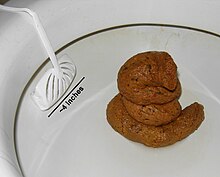
Back براز بشري Arabic মানৱ বিষ্ঠা Assamese মানব বিষ্ঠা Bengali/Bangla Lidský výkal Czech ބޮޑުކަމުދާ ތަކެތި DV مدفوع انسان Persian Matière fécale humaine French Kashin mutum Hausa मानव मल Hindi Nsị mmadụ IG

Human feces (American English) or faeces (British English), commonly and in medical literature more often called stool,[1] are the solid or semisolid remains of food that could not be digested or absorbed in the small intestine of humans, but has been further broken down by bacteria in the large intestine.[2][3] It also contains bacteria and a relatively small amount of metabolic waste products such as bacterially altered bilirubin, and the dead epithelial cells from the lining of the gut.[2] It is discharged through the anus during a process called defecation.
Human feces has similarities to the feces of other animals and varies significantly in appearance (i.e. size, color, texture), according to the state of the diet, digestive system, and general health. Normally, human feces are semisolid, with a mucus coating. Small pieces of harder, less moist feces can sometimes be seen impacted in the distal (final or lower) end. This is a normal occurrence when a prior bowel movement is incomplete, and feces are returned from the rectum to the large intestine, where water is further absorbed.
Human feces together with human urine are collectively called human waste or excretion. Containing human feces and preventing spread of pathogens from human feces by the fecal–oral route are the main goals of sanitation.
- ^ "Stool".
- ^ a b Tortora GJ, Anagnostakos NP (1987). Principles of anatomy and physiology (Fifth ed.). New York: Harper & Row, Publishers. p. 624. ISBN 978-0-06-350729-6.
- ^ Diem K, Lentner C (1970). "Faeces". in: Scientific Tables (Seventh ed.). Basle, Switzerland: CIBA-GEIGY Ltd. pp. 657–60.